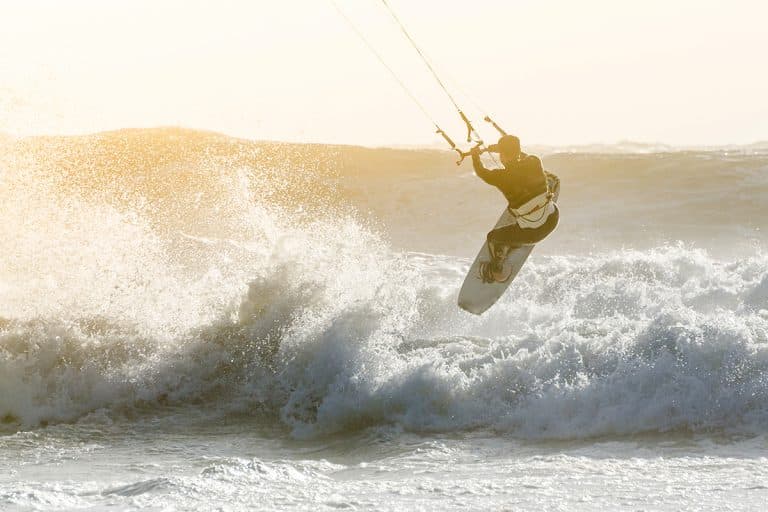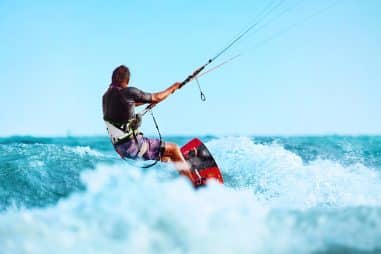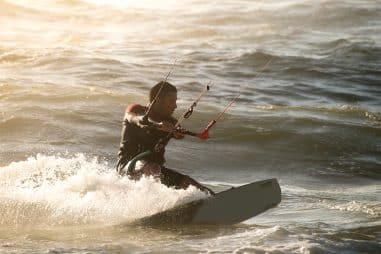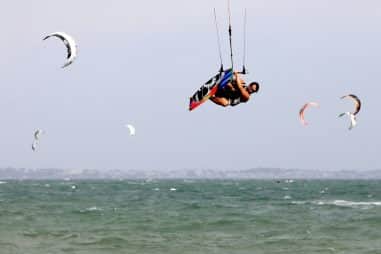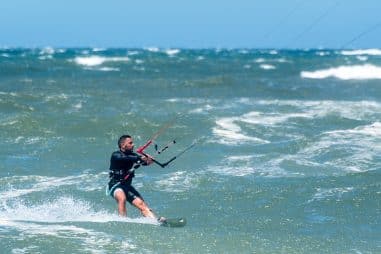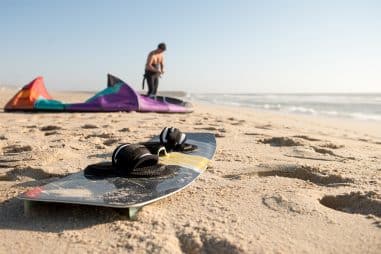Before jumping in the water, you would need to rig your own kitesurfing kite to use the power of the wind to generate speed. A control bar that is connected to the kite is used for navigating while kitesurfing. Steering the kite is much more like driving a bicycle than a vehicle. As you master the basics of kitesurfing you will have a lot of fun by doing your jump tricks or even ride a big wave on the ocean.
How Do I Prepare for Kitesurfing?
Same as other sports, you can prepare for kitesurfing by doing rudimentary exercises to condition your mind and body. 5 to 40 minutes of workout on the surface will have a big difference than just jumping directly on the water. Preparing off the water will surely reduce muscle soreness and avoid injury while kitesurfing.
This pre-kitesurfing exercise is entirely up to you on what areas you would like to improve. Some kitesurfers prioritize stretching, muscle workout, and core strength exercise while others choose to improve their balance and stability to have more control over their kite and board. These physical preparations are often ignored however they will significantly improve your kitesurfing experience.
How Do You Rig Kitesurfing Kites?
Rigging your kitesurfing kite can be a bit tricky when doing it the first time. The following steps will help you ease out while setting up your kitesurfing gears.
- Check wind direction: To rig kitesurfing kite, you need to check first where the wind is coming from. The wind direction determines where will you be placing your surfing gear.
- Unfolding the kite: After checking the wind, begin facing downwind and you would want to place the kite on your downwind side. Unfold the kite with the Leading edge upwind.
- Set-up your pump: Attach your pump to the loop on the leading edge or attach your harness to the loop if your pump doesn’t have one. This will prevent the kite from blowing away when inflating.
- Attach pump hose: Attach the pump hose to the inflation valve on the kite. Some kites have a separate inflate and deflate valve. Make sure to close the deflation valve if the kite has one.
- Pump your kite: Begin pumping the kite up to the recommended pressure. Each kite has a different recommended pressure. Check the pressure on the pressure gauge on your pump.
- Check kite pressure: To check if you have inflated the kite to the recommended pressure you can feel it by gripping the leading edge if there is enough air or if it is underinflated.
- Cover the valve: Once the kite is inflated remove the pump hose then cover the valve. Completely secure the cover of the valve to prevent it from falling off.
To be completely secure you can ask an experienced kiter or your instructor to check your kite if you are not yet confident with your rigging skill. After all these careful preparations you will be able to enjoy kitesurfing when riding on a well set-up kite.
Can You Kitesurf With a Trainer Kite?
A trainer kite’s purpose is to help you learn how to kitesurf. There are different types of trainer kites. Depending on where you prefer to train to fly determines the type of kite you want to buy. A leading-edge inflatable kite (LEI) is great for water because of its inflated blades that cause it to float on water.
Closed-cell foil kite can be used for both land and water. Last, of all, the open cell foil kites can only be used on land. It is the best kite if you want to practice on dry land and didn’t have the luxury to travel all the way to the beach. Carefully consider these types of kites before deciding to buy a training kite to maximize your training.
How Do You Control Kitesurfing Kites?
You control the kitesurfing kites by pulling one side of the control bar in while pushing out the other side of the bar. Pulling the left bar turns the kite to the left while pulling the right bar turns the kite to the right.
Pulling the whole control bar in towards your body increases the power of the kite. Whereas pushing the control bar away from your body decreases the power of the kite. Letting go of the control bar depowers the kite.
How Do You Steer a Kitesurf?
You have to pull one side and push the other side of the control bar to steer the kite. To steer to the left you need to pull the bar to the left and push the right side of the bar. To steer to the right, you just pull the bar to the right and push the left side.
Practicing with a trainer kite will help you learn how to smoothly steer to the left or the right. As much as possible try to avoid pulling the bar too hard when steering.
How Do You Stand Up When Kitesurfing?
Before you begin standing up while kitesurfing, you first need to learn how to control the kite and master upwind body drag to get back to your board. The following steps will help you to stand up when kitesurfing or to water start.
- Sit back: Sit back on the shallow water with the wind directly on your back.
- Put feet on board: Use the board handle to get your feet in position.
- Tuck your knees: Keep your knees as close to your chest as possible.
- Position yourself: Keep the bar, the board, and the kite in parallel in position.
- Send the kite: Pull the kite to increase the power on the kite.
- Stand up: Get your head towards your toes to stand up.
- Ride on: Begin riding your board towards the direction of your kite.
How Do You Switch Feet in Kitesurfing?
Switching feet in kitesurfing may not be that easy for beginners. You will need a lot of practice and confidence in riding your board. A good balance and timing will help you switch feet easily while kitesurfing.
- Steer the kite: First, you want to slowly steer the kite up to 12 o’clock to slow down.
- Gain some lift: Then grab the bar with both hands then pull the bar in to gain some lift.
- Switch your feet: Switch your front foot to your back foot with the center of your body weight over the center of the board.
- Regain speed: Steer the kite down again to gain speed again and continue kitesurfing.
The crucial point of this movement is your body weight. Try not to have too much weight on the back or in the front of the board. A successful footswitch takes a lot of time, just continue practicing and don’t get frustrated if you don’t get it the first time.
How Do You Start Beach Kitesurfing?
There are a couple of ways to start kitesurfing from the beach. First off, place yourself in the sand just a little bit out of the water but close enough that you can just jump into the water. Use your kite to give you lift from sand into the water.
Another way is starting in ankle-deep water. Once you set your feet on your board just pull the kite to the direction you want to travel. The kite will pull you and your board out of the shallow water and now you are kitesurfing.
How Do You Slow Down When Kitesurfing?
There are various approaches you can do to slow down. One way is to place your kite at 12 o’clock when kitesurfing to kill speed and make sure to take the kite out of the power zones. Another way you can do is to edge hard upwind or you can push the bar away from your body to decrease power.
Controlling your speed when kite surfing is essential in kitesurfing. Slowing down starts by slowing down your board. You can do this by applying weight on your board by carefully leaning your upper body backward but not so much that you will end up landing on your back.
How Do You Stop When Kitesurfing?
You can stop kitesurfing by simply edging your board upwind. If you are having trouble stopping start by slowing down first by killing your speed. You can do this by pressing through your backfoot, twisting your hips, or pulling the trim strap to further depower until you completely stop.
Another way to stop is when you are nearing the beach shore. Doing beach stop is easy just bring the kite to 12 o’ click while nearing the seaside and wait for the board to stop. You can also do jump stop tricks or board pop stop if you would want to exit the beach with style.
How Do You Ride Waves When Kitesurfing?
Wave riding is one of the most enjoyable and exciting experiences in kitesurfing. Having a kite while riding a wave can be an advantage or a burden while riding a wave. Knowing how coordinate your kite, balancing your board, and predicting waves are crucial in wave riding. Below is a guide you can follow when riding waves while kitesurfing.
- Use the kite: Unlike surfing, kitesurfing also uses a kite to steer aside from the board. When riding a wave consider the direction the kite and steer depending on the wave. You may want to keep the kite low when riding a wave to keep you on the wave.
- Get in the wave early: The best way to ride a wave is to catch it out before it is fully formed. Understanding how a wave is formed and breaks will help you decide when to ride it or if you are too late to ride it.
- Practice carving: Learning how to carve is crucial in riding a wave. Approaching a wave can be tricky but a proper carve across the wave can get you riding on the wave smoothly. You may also want to practice riding frontside or backside.
- Foot Change: As the wave forms and breaks, a foot change may at times be necessary. A quick foot change can be tricky while riding a wave but this delicate technique can help you ride more waves and maintain balance on your board.
How Do You Transition When Kitesurfing?
A kitesurf transition lets you change direction without needing to stop and do water start again for each turn. Learning to transition will let you stay dry and continuously surf upwind. Here are steps on doing transition when kitesurfing.
- Slowdown: First, reduce speed by bringing your kite slightly higher and push the bar out to slow down.
- Slowest speed: Once you are at the slowest speed or almost at a stop it’s time to switch your stance.
- Transition: Moderately slide your back foot forward so it becomes your leading foot.
- Redirect kite: Then redirect the kite to the new direction you want to go.
- Foot Position: Your old backfoot is now your new leading foot and should be pointing downwind.
- Gain speed: Pull the bar to gain speed in the new direction you are now going.
How Do You Jump When Kitesurfing?
There are three main parts to successfully pull off a jump when kitesurfing. These three parts are the take-off, in the air, and your landing. Follow the steps below and land your first kitesurf jump.
Take off
- Generate speed: To prepare for take-off you would want to build up enough speed. Depending on the wind you may want to set your kite around at 10 o’clock or if it is very windy set it closer to 11 o’clock.
- Maintain speed: Keep your speed while edging and choose a spot to perform your jump. You should feel that there is a tension building up with your lines. This time you may want to make sure you are well-distanced from other surfers before performing the jump.
- The jump: Now you are set for the jump. Quickly send the kite by moving the kite to 12 o’clock and pulling the bar in. Wait for the kite to be above you and then lift your surfing board. Jumping at times won’t be necessary as the tension built up on the lines and the kite will lift you.
In the air
- Maintain your balance: Remember to keep your knees towards your body. This will help you gain more control of the board and avoid swinging while in the air. Take note to feel the warm air and enjoy the view.
- Control your kite: Pull the control bar down to produce tension on the steering lines. While in the air ensure that the kite is at 12 o’clock then slowly redirect your kite forward as you slowly begin to land. Start planning your landing spot as you approach the water.
The Landing
- Direct kite forward: Move your kite forward to regain speed. Don’t overpower the kite as you would want the have a smooth landing.
- Spot your landing: Quickly check your landing spot.
- Position your board: Put the nose of your board facing downwind. This will help you soften your landing.
- Bend your knees: As you land keep your knees bend to absorb the impact.
- Surf away: Regain your speed as you wave back at your friends after nailing that awesome jump.
How Do You a Jump Transition When Kitesurfing?
A jump transition is an advanced kind of transition. To do this cool transition steer your kite from 12 o’clock to 1 o’clock quickly. Before the bar reaches 1 o’clock start pulling the bar in while edging upwind.
Prepare to jump transition by keeping your legs in just a bit to produce tension and then jump. Transition the weight on your back foot depending on the new direction you want to go. Redirect your kite to your new destination and straighten your legs again while leaning on your back foot.
How Do You Get Big Air When Kitesurfing?
Kitesurfing jumps requires lots of training and surfing knowledge. To get a big air when kitesurfing you would want to gain more speed and momentum when riding. Place your kite around 10 o’clock to generate more power. The faster you are and the hard you edge the higher the jump will be.
Upon reaching your comfortable high speed you are now ready to jump. Pull the bar while smoothly steering the kite from 10 o’clock to 12 o’clock. Your kite will take you higher depending on your speed. Big air kite does not always translate to big airs, it is the combination of the wind, speed, and timing that will get you big airs.
Can You Kitesurf Upwind?
Riding upwind enormously improves your kitesurfing experience. There are many ways to improve your ride upwind. Having a proper kite position, speed, and body posture will ease you in riding upwind. Mastering riding upwind will maximize your time on the beach.
As you become more comfortable with your kitesurfing skills it will be best to learn to ride upwind. After you ace your board start, transitions, and jumps you may want to unlock a new skill by riding upwind.
How Do You Kitesurf Upwind?
After learning to surf downwind it’s time to learn to ride upwind. Learning to ride upwind will save you a lot of time and energy walking back to the shore. Having to repeatedly do the ‘walk of shame’ back to the beach is very exhausting after performing that cool kitesurfing tricks at the sea.
Here are tips and tricks to guide you in kitesurfing upwind.
- Start downwind and edge: Before riding upwind, you first need to start downwind to gain speed. After getting enough speed you can begin turning upwind at the same time put more pressure on your back foot and steer the board to the direction you want to go.
- Position your kite: Having the right kite position while riding against the wind is crucial in gaining your speed. Once you are riding upwind you will need to steer your kite around 45 degrees or 10 or 2 o’clock. Park your kite at 45 degrees when you gain enough speed.
- Body stance: The best position is to have the board and your kite at 45 degrees against each other. Your front leg should be straight or nearly straight and your rear leg slightly bent while using it to steer upwind. Arms should be stretched out and your head and body should face the direction you are going.

